Neil suggested we up the ante and approach Green from the distant east. Our bushwhack route would start from highway 9 and proceed six miles over Iron Mountain, Owl Head Lookout, and along Green's ridge to its summit. Our return route would descend to the North Trail and follow it out to 9N. The proposed itinerary was more challenging than the "trade route". However, satellite imagery showed exposed outcrops and slides along the way so the payback would be scenic views. I was instantly sold on the idea.
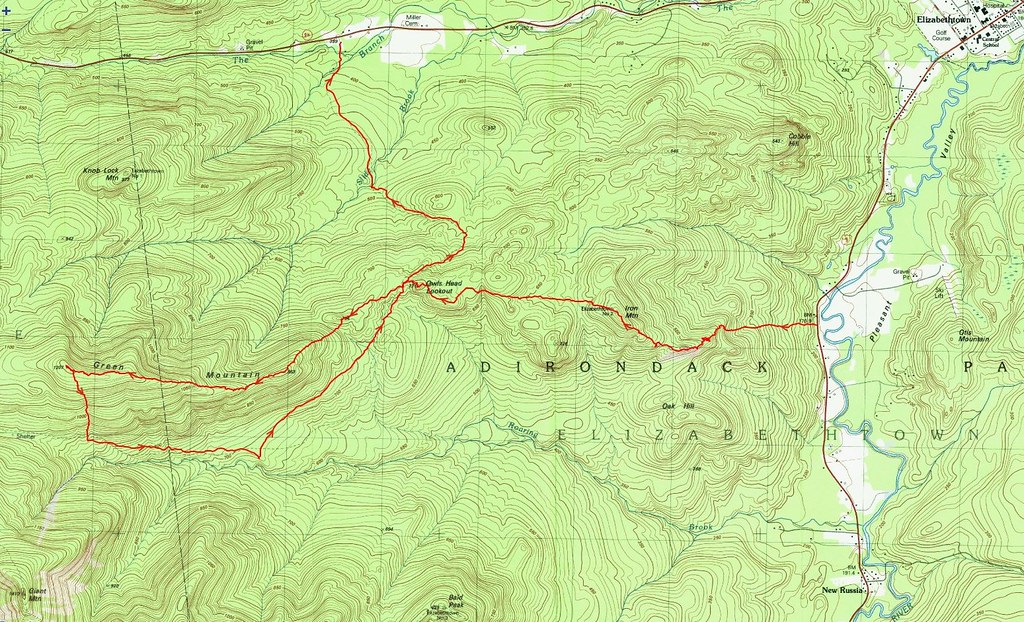 |
| Our route from 9 to Iron, Owl Head, Green, and 9N. |
 |
| Aerial view. |
At 7:45 AM we bid Tom goodbye and immediately began ascending the steep embankment. After climbing about 150 feet, we were surprised to intersect an old road. We continued our ascent and crossed, re-crossed, and followed the road until it no longer coincided with our desired trajectory. The woods were surprisingly free of underbrush and, with a thick carpet of fallen leaves, made for very easy travel; there was no "bushwhacking" involved.
 |
| Hemlock Varnish Shelf (Ganoderma tsugae) |
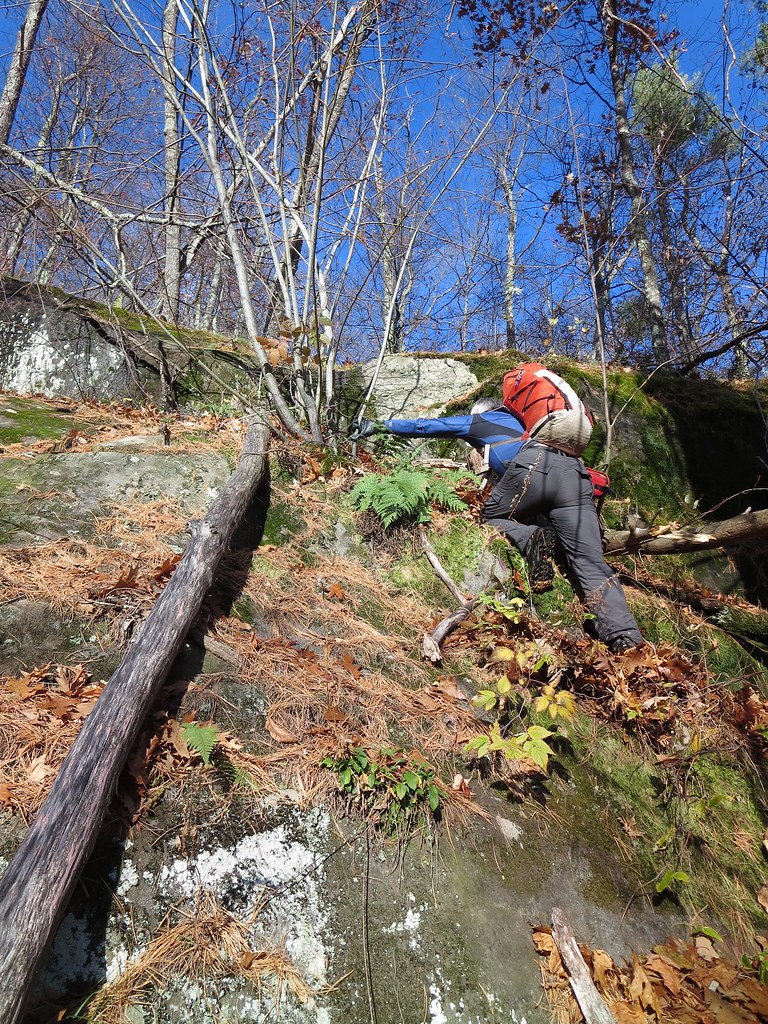 |
| Working hard. |
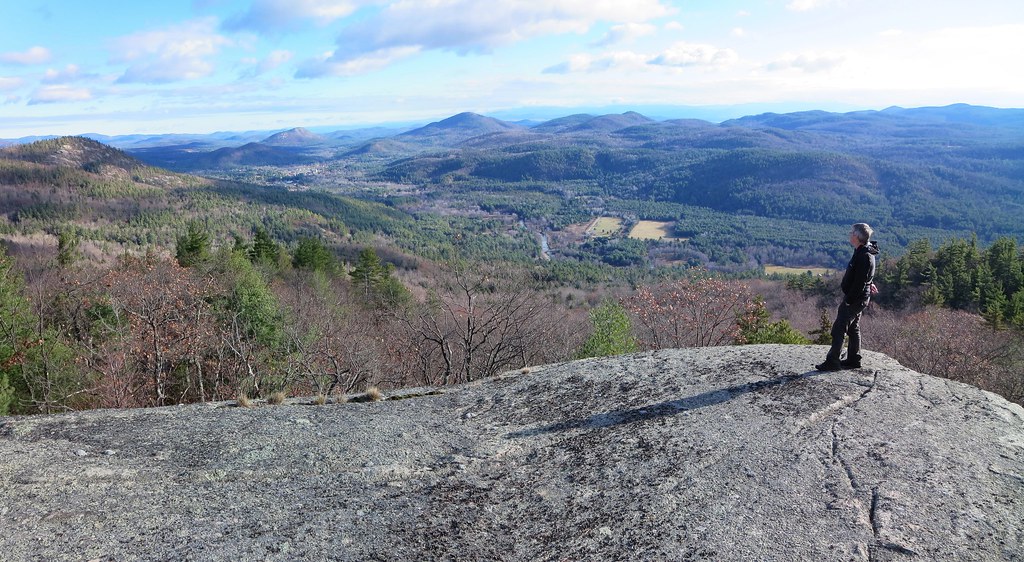 |
| First clear view of Elizabethtown. |
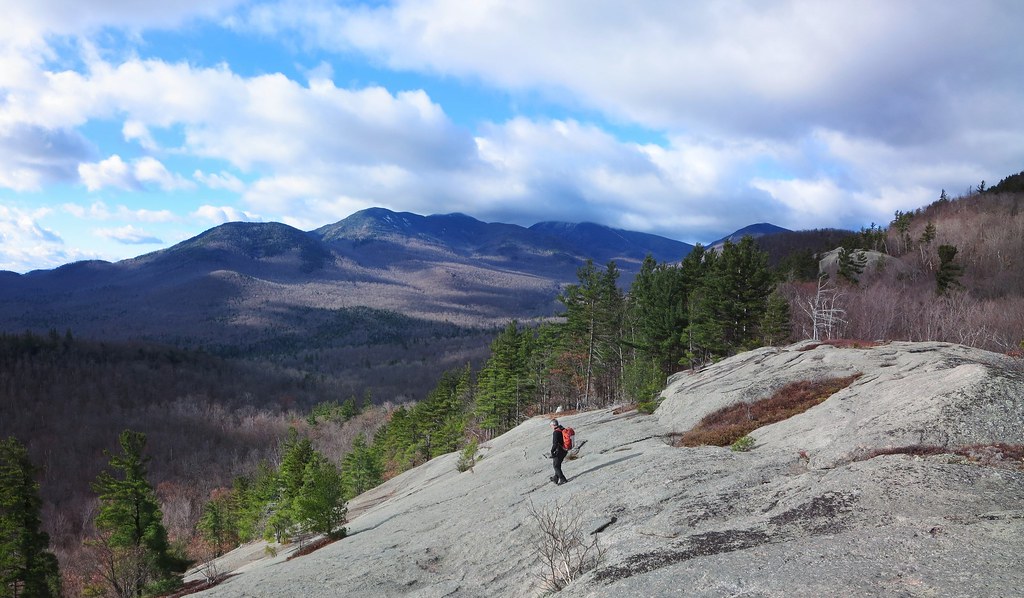 |
| Neil explores the bare slope. |
 |
| Easy walking. |
After climbing out of the drainage, the terrain returned to gentle slopes with broadly spaced trees and a deep carpet of leaves. Through the leafless trees we could see the outline of distant Bald and Rocky Peak Ridge. Its an outstanding place for anyone looking for an easy "bushwhack".
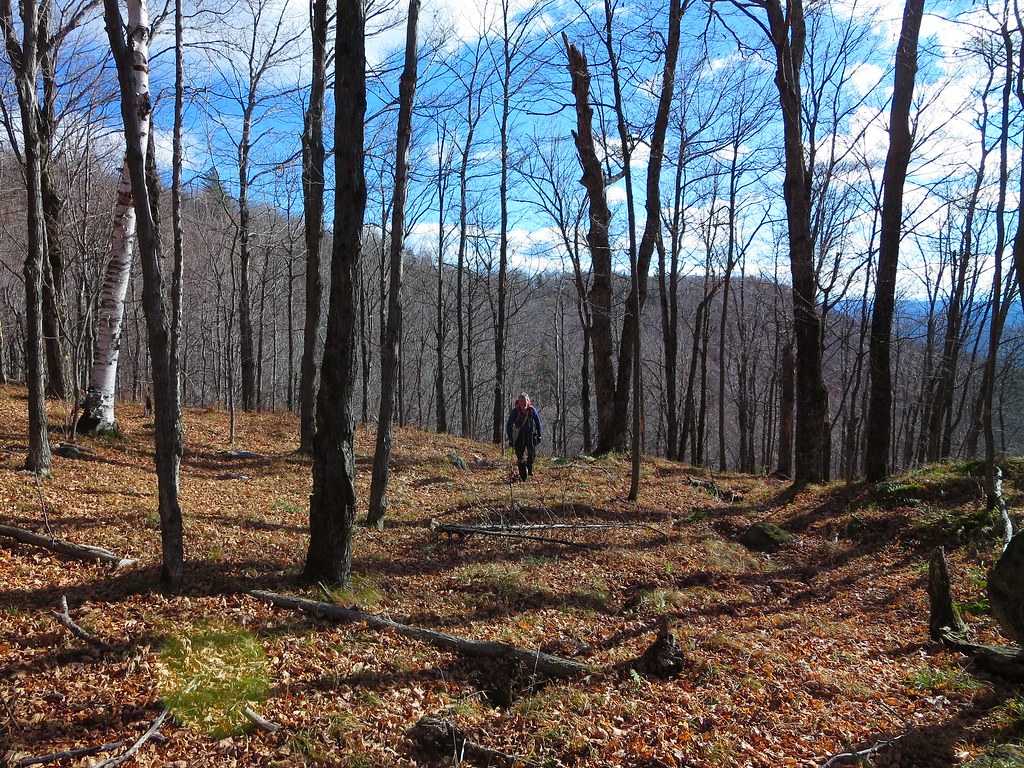 |
| Park-like woods. |
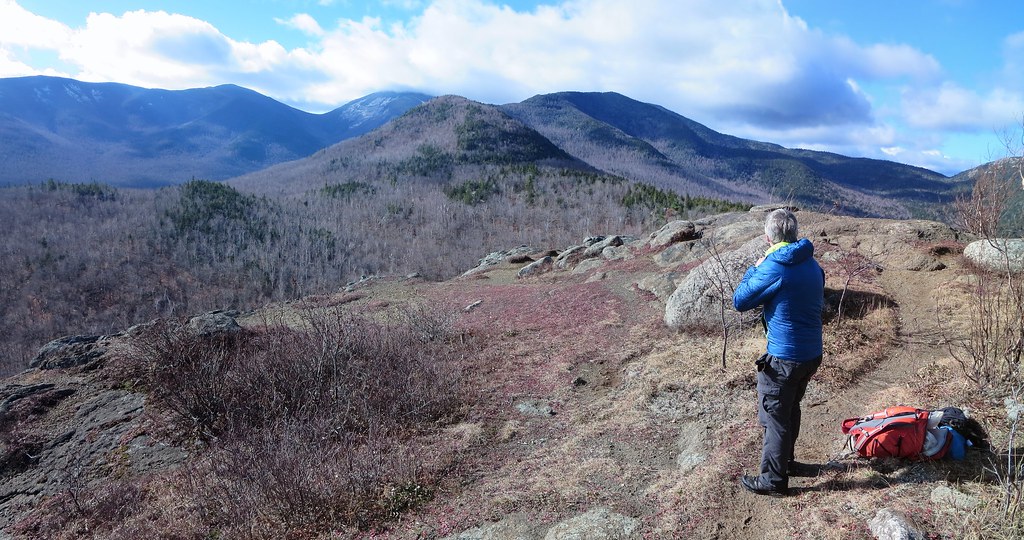 |
| Owl Head Lookout. |
After a quick snack, and several photos of our intended destination, we made the short descent to the North Trail. We followed it for a few yards and then cut into the woods. The conditions became decidedly more "Adirondack" and we were greeted with thick firs and downed trees. Fortunately, it was short-lived and soon we were moving along at a good clip.
We had studied our route from Owl Head Lookout but nothing prepared us for the rocky knob we named "Owl Head Two". Lying a half-mile west-southwest of Owl Head, "OH2" stands a few yards taller than OH1. Its south side is steep, exposed rock and, with limited daylight, we chose not to ascend it. However, it appears to be well worth one's time to explore. The col west of OH2 is a rugged place littered with huge boulders.
 |
| The rocky knob we called "Owl Head 2". |
We contemplated skirting them by either heading north, to the col's height-of-land, or south, deeper into the drainage. We chose to get a closer look and discovered we could thread a route between the cliffs. Whereas navigation was easy, scrambling up the steep slope was not.
After clearing the steepest section, we breathed easy and settled into a steady rhythm. The sun was now lower in the sky and our route ran in the cooler shadows. We noticed the first signs of snow accumulation. It looked like rock salt and it seasoned the moss and fallen leaves. Upon reaching the top of the climb, we re-joined the warm, sunlit, snow-free side of the mountain.
The next half-mile was a treat. Rising only 100 feet over its length, it is covered in tall grass, (prickly) underbrush, and sparse trees. Standing 900 feet above High Bank (on the North Trail), it offers unimpeded views of Roaring Brook valley and the ridge running from Bald to RPR and on to Giant. A braided game trail runs its length. It is also the last stretch of open woods along Green's ridge. The last mile to the summit is the typical Adirondack terrain one finds above 3000 feet, namely an abundance of conifers and blowdown.
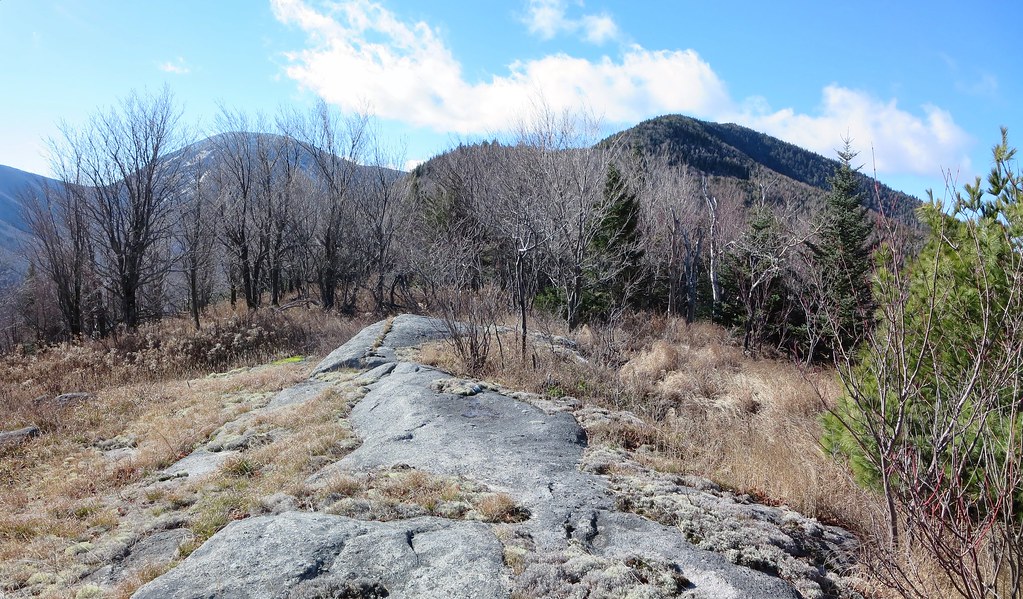 |
| Beautiful open woods along Green's ridge. |
Attempting to remain exclusively on the ridge's centerline became difficult. We dropped a few yards down the north side where we found a steep slope but open woods. I also got a peek of rocky Knob Lock mountain. Neil explained it was well worth a visit and could be incorporated into a trip to Green from route 9 (as he had done in the past).
I didn't expect much from Green's summit. It is completely wooded, quite flat, and, despite relatively open woods, no views. We had followed a game-trail/herd-path but it did not lead to a marked summit. Unlike many other peaks, I found no sign, leftover canister mountings, blaze, flagging, cairn, trodden patch of ground, or other evidence of a "herd-summit". To stand atop a peak that hasn't been marked is both satisfying and perplexing; you felt like the first person to reach it or like someone who simply hadn't found the true summit.
After scouting the area, I settled on a mossy boulder to represent the highest point even though some nearby ground seemed equally tall. I'm not sure why I bothered but it seemed important at the time. The ground was bleached white by a thin blanket of snow and the late-afternoon sun streamed in through the trees. It was the best Green could muster to welcome us to its summit and it was appreciated.
 |
| Green's approximate summit. |
A quick check of the map showed a drainage running down Green's south face. It intersected the North Trail about a half-mile east of Giant lean-to. We knew there were cliffs so we bet on the drainage to create a navigable path through them. The gamble paid off. We easily threaded our way through the steepest sections and dropped 1000 feet over 0.6 miles in 45 minutes (~2 mph) which is a respectable clip for bushwhacking.
Upon intersecting the North trail we paused to strip off layers, have a bite, and prepare for the final five mile trail-walk back to my car. There would be a 450 foot ascent beyond High Bank but until then it would be an easy-peasy gradual descent along a smooth trail. We wouldn't exit before sunset but we would cover the five miles in two hours.
At High Bank we met the only other hiker of the day. I believe his name was Bob and he had just returned from the base of the slides on Giant's east face. A resident of Lake Placid and an avid backcountry skier, he had lost a ski while descending the slides a few years ago. He returned to explore the area and, for fun, attempt to locate the lost ski. We spent several minutes chatting with him and he recounted many examples of what experienced local skiers had accomplished in the High Peaks.
It was now close to 4:00 PM and sunset was a mere half-hour away. Bob joined us and we chatted all the way back to the car. The final 450 foot ascent to the Owl Head junction did not go by unnoticed. After a steady climb the grade diminished and I thought the junction to Owl Head Lokout must be just a few yards away. I looked up and saw, illuminated by the day's last dim light, Owl Head about a half-mile away. Well darn! I forgot there was a brief high-point before the trail descended into a drainage and rose to meet the spur-trail to Owl Head. We passed the junction at sunset.A half-hour past the junction, twilight was lost so we stopped at Slide Brook to don our headlamps. The remaining mile flew by in the darkness. At the trail-head we thanked Bob for his company and said our goodbyes.
Neil and I proceeded with our usual post-hike preparations for the drive home (change into clean clothes, bag and stow dirty gear, retrieve wallets and passports, inspect ground for dropped items, etc). We made one quick stop at Stewarts in Elizabethtown to replace lost calories and fill up with comparatively cheap US gasoline (US$2.45/gallon or, at 35% exchange rate, CDN$0.87/liter vs $1.10/liter in Montreal). Under a clear and starry sky, we drove home while recounting the amazing things we had seen. Visiting Green by way of Iron and Owl Head is a wonderful hike.
Stats
Distance: 12 miles.Ascent: 4850 feet.
Time: 9h 37m.
Photos
My photos.Neil's photos.
No comments:
Post a Comment